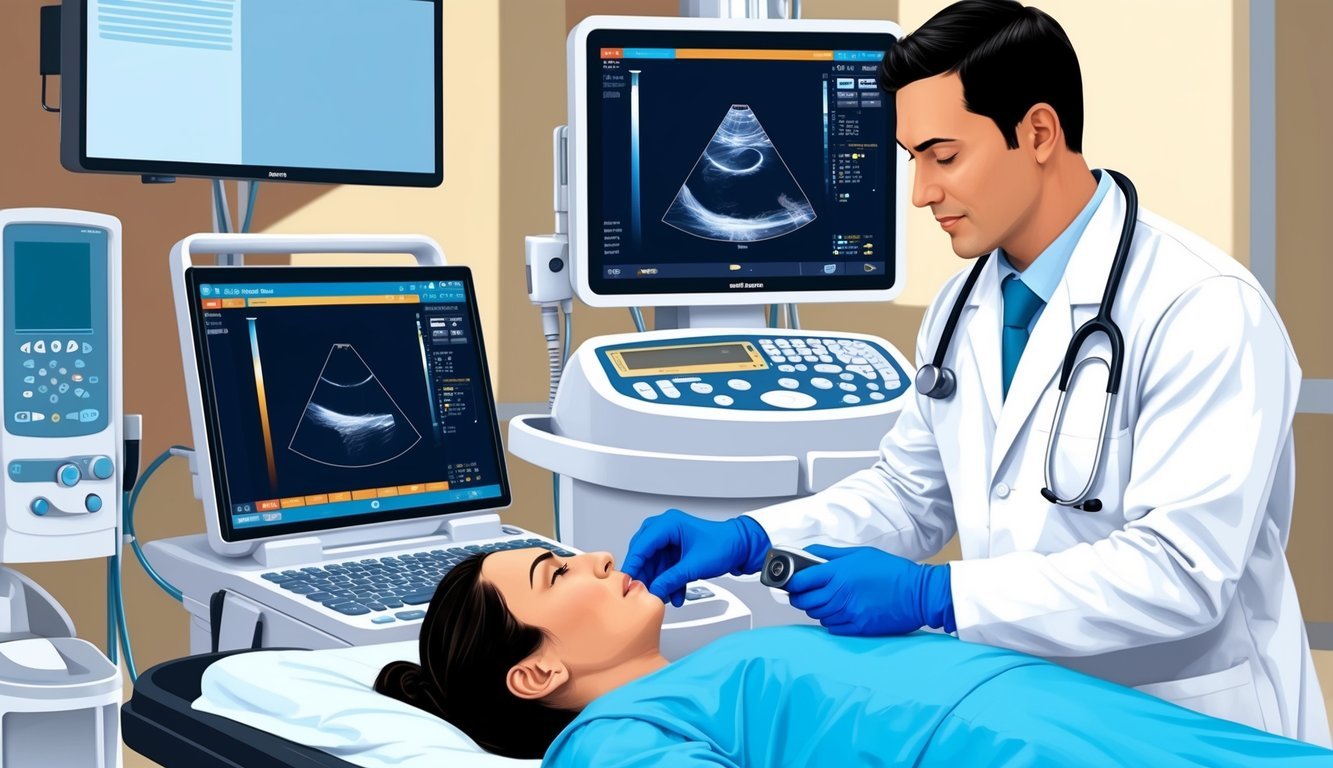Becoming an ultrasound technician in Texas can be a rewarding career choice for those interested in the medical field. On average, it takes around 2 to 4 years to complete the necessary education and training. This timeframe includes obtaining a degree, completing clinical training, and possibly earning certifications.
Understanding the steps involved in becoming an ultrasound tech can help you plan your path effectively.
The process involves various educational programs, hands-on training, and specializations in sonography.
You will need to ensure you meet state requirements and consider the credentials that can enhance your job prospects.
Many graduates find ample opportunities in hospitals, clinics, and private practices throughout Texas, making it a promising field.
Whether you are starting from scratch or looking to switch careers, knowing how long it typically takes can help you make informed decisions.
Factors such as your chosen program and any specializations can impact your timeline.
Key Takeaways
- It typically takes 2 to 4 years to become an ultrasound technician in Texas.
- Completing clinical training is crucial for hands-on experience.
- Earning certifications can improve job prospects in sonography.
Pathways to Becoming an Ultrasound Technician in Texas

There are several important steps to consider when aiming to become an ultrasound technician in Texas.
From preparing in high school to selecting the right educational route, each stage is crucial for success in this field.
High School Preparation and Prerequisites
Your journey begins in high school.
It is essential to obtain a high school diploma or GED.
Focus on courses in biology, mathematics, and health sciences, as these subjects will provide a solid foundation for your future studies.
In addition to academic preparation, consider developing skills in communication and critical thinking.
These skills are vital for patient interaction and understanding complex situations in a clinical environment.
Some programs may have specific prerequisites, including volunteer or work experience in a healthcare setting.
Check the requirements for any prospective programs you are interested in, as they can vary.
Educational Routes
There are different educational paths you can take to become an ultrasound technician in Texas.
Most commonly, you will pursue an Associate or Bachelor’s degree in sonography or a related field.
-
Associate Degree: This is typically a 2-year program offered by many community colleges. Some options include:
- Alvin Community College
- Austin Community College
- Del Mar College
-
Bachelor’s Degree: A 4-year program may provide more specialized knowledge and skills. This path can lead to advanced roles in the field.
-
Certificate Programs: For those who already hold a degree in a healthcare-related field, a certificate program could be a faster route into sonography.
Make sure your chosen program is accredited, as this will affect your eligibility for certification exams.
Accreditation and Educational Institutions
Choosing an accredited program is vital.
Accreditation ensures that the education you receive meets specific standards.
The Commission on Accreditation of Allied Health Education Programs (CAAHEP) is the primary accrediting body for sonography programs.
Here are some accredited institutions in Texas:
| College/Institute | Program Type |
|---|---|
| Alvin Community College | Associate Degree |
| Austin Community College | Associate Degree |
| Lone Star College-Cy Fair | Associate Degree |
| Temple College | Associate Degree |
| Del Mar College | Associate Degree |
| Weatherford College | Certificate Program |
Completing an accredited program is essential for taking the certification exam and obtaining a job in the healthcare field.
Always verify that your program meets CAAHEP standards before enrolling.
Certifications and Licensure for Ultrasound Technicians
Becoming an ultrasound technician requires specific certifications and licensure to ensure you meet the standards of the profession.
This process involves obtaining credentials from recognized organizations and fulfilling state requirements.
Here’s what you need to know about certifications and state licensure in Texas.
Certification Bodies
Several bodies offer certification for ultrasound technicians.
The most recognized are:
- American Registry for Diagnostic Medical Sonography (ARDMS): This organization provides certifications for various sonography specialties.
- American Registry of Radiologic Technologists (ARRT): They offer certificates in sonography, focusing on radiologic technologists who want to expand their skills.
- Cardiovascular Credentialing International (CCI): CCI specializes in cardiovascular sonography certifications.
These organizations have strict eligibility requirements, including completing an accredited program and passing exams.
Check each organization’s website for specific details on qualifications.
Certification Exams
To become certified, you must pass an exam from one of the certification bodies.
For example:
- ARDMS offers various exams such as the Adult Echocardiography or Registered Diagnostic Medical Sonographer (RDMS).
- ARRT has a Radiologic Technology exam that can include sonography.
You need to prepare thoroughly for these exams, as they evaluate both knowledge and practical skills.
You can find study guides and preparation courses to help you succeed.
State Licensure
In Texas, ultrasound technicians are required to meet specific licensure requirements set by the Texas Medical Board.
To practice, you typically need to hold a certification from a recognized organization, such as ARDMS or ARRT.
In addition to certification, you may need to submit proof of your education and proof of passing the required exams.
Be sure to keep updated with any changes in state regulations as they can vary.
Continuing Education and Recertification
Continuing education is crucial for maintaining your certification and licensure.
Most certifying bodies require a certain number of continuing education (CE) hours every few years.
For instance:
- ARDMS requires 30 CE credits every three years.
- ARRT has a similar requirement but supports a broader range of educational activities.
Plan ahead for these requirements, as they not only ensure you stay updated in your field but are also necessary to keep your credentials valid.
Keep track of your education hours and carefully document your courses for easy access during the recertification process.
Clinical Training and Hands-On Experience

Clinical training is essential for becoming an ultrasound technician in Texas.
It involves both formal education and practical, hands-on experiences.
You will engage in an educational curriculum and a clinical externship, which are critical for developing the necessary skills.
Educational Curriculum and Clinical Externship
Your educational journey typically begins with a diagnostic medical sonography program.
These programs often include courses on human anatomy, medical terminology, and the use of ultrasound equipment.
Most programs combine classes with clinical training, ensuring that you gain practical knowledge.
During your clinical externship, you will work in a healthcare setting under the supervision of experienced professionals.
This supervised experience allows you to apply your classroom learning.
You will practice using imaging equipment while gaining exposure to various medical conditions you may encounter in practice.
Completing a clinical externship is crucial.
It provides you with hands-on experience and helps you build necessary communication skills critical for patient care.
Skill Development
Skill development occurs throughout your training and clinical experiences.
You will learn to operate different types of ultrasound machines and produce high-quality images for diagnostic purposes.
As you progress, you will also focus on developing your patient care skills.
Engaging with patients is essential, as you must explain procedures and ensure their comfort.
Being proficient in medical imaging techniques also requires an understanding of various procedures and protocols.
Training programs emphasize both technical skills and interpersonal skills.
This balanced approach prepares you to meet the demands of a sonographer’s role.
Practical experience reinforces these skills, making you job-ready upon completing your program.
Specializations in Sonography

Sonography offers various paths you can take, depending on your interests and career goals.
Each specialization focuses on different areas of the body and types of diagnostic imaging.
Here are the key specializations you may consider.
General Sonography
General sonography involves creating images of various organs and structures in the body, including the abdomen, pelvis, and soft tissues.
You will often perform abdominal scans, obstetric evaluations, and gynecological examinations.
Training in general sonography usually includes an associate’s or bachelor’s degree in diagnostic medical sonography.
You will learn to operate ultrasound equipment, interpret images, and communicate findings to physicians.
General sonographers must have strong technical skills and attention to detail as they play a crucial role in diagnosing conditions.
Becoming certified through a recognized body, such as the American Registry for Diagnostic Medical Sonography (ARDMS), may also enhance your employment prospects.
Cardiac Sonography and Vascular Technology
Cardiac sonography focuses specifically on the heart and its functions.
As a cardiac sonographer, you will perform echocardiograms to assess cardiac anatomy and blood flow.
Vascular technology, on the other hand, deals with the blood vessels and circulation.
This specialization involves evaluating vascular conditions such as arterial blockages and venous disorders through ultrasound.
Both fields require specialized training and certification.
You will learn to use advanced imaging techniques and understand cardiovascular physiology, which is essential for accurate diagnosis and treatment planning.
Neurosonology and Pediatric Echocardiography
Neurosonology is a specialized area focusing on imaging the brain and nervous system using ultrasound.
It is commonly used in neonatal settings to assess brain development and detect abnormalities.
Pediatric echocardiography involves imaging the hearts of infants and children.
It requires knowledge of the unique anatomical and physiological differences in pediatric patients.
Both specializations require extensive training in ultrasound techniques specific to the respective fields.
Certification may be obtained through organizations like the ARDMS, helping you advance your career in these specialized areas.
Each of these specializations offers unique opportunities and requires a commitment to ongoing education to stay current in the ever-evolving field of sonography.
Career Outlook and Salary Expectations in Texas

In Texas, the career outlook for ultrasound technicians is promising, with strong job growth and competitive salaries.
This section covers the job market dynamics, average salaries specific to the region, and opportunities for advancement within the healthcare field.
Job Market and Employment Growth
The job market for ultrasound technicians in Texas is expanding.
According to the U.S. Bureau of Labor Statistics, employment for diagnostic medical sonographers is expected to grow by 11% from 2023 to 2033.
This growth is faster than the average for all occupations.
Factors contributing to this increase include an aging population requiring more diagnostic imaging services and advancements in ultrasound technology.
As more healthcare facilities adopt these technologies, the demand for skilled technicians will continue to rise.
Average Annual Salary and Factors Affecting Pay
In Texas, the average annual salary for an ultrasound technician is $78,210.
However, salaries can vary based on several factors including experience, location, and work environment.
Here’s a breakdown of the salary range:
| Experience Level | Average Salary |
|---|---|
| Entry-Level | $59,640 |
| Median | $78,210 |
| Top 10% | $101,650 or more |
Additionally, certifications in specialized areas can enhance earning potential.
Those with advanced certifications often command higher salaries compared to their peers.
Opportunities for Advancement
Career advancement opportunities are robust within this field.
You can pursue advanced certifications, which may lead to specialized roles such as abdominal or vascular sonography.
Many ultrasound technicians also choose to specialize in areas like cardiac sonography or sonographic imaging.
Further, as you gain experience, there are opportunities to move into supervisory or teaching positions.
Engaging in professional development can enhance your skills and increase your job satisfaction.
Consider continuous education options to stay updated on technological advancements and best practices in the field.
Frequently Asked Questions

This section addresses common questions about becoming an ultrasound technician in Texas.
You will find specific information related to educational requirements, program options, and salary expectations.
What are the educational requirements to become an ultrasound technician in Texas?
To become an ultrasound technician in Texas, you typically need a high school diploma or GED.
After that, you should complete an accredited ultrasound technician program.
These programs can offer either an Associate’s degree or a Bachelor’s degree, which prepare you for certification.
How many years of study are required to work as a certified ultrasound tech in Texas?
You can complete an Associate’s degree program in ultrasound technology, which usually takes about two years.
A Bachelor’s degree will require four years of study.
Most students opt for the shorter Associate’s degree to enter the workforce more quickly.
What is the fastest pathway to becoming an ultrasound tech in Texas?
The quickest route is to complete a two-year Associate’s degree in diagnostic medical sonography.
Upon finishing your degree, you can take certification exams to start working.
Accelerated programs may also be available to reduce your time in school.
Can I complete an ultrasound tech program online in Texas, and if so, how long will it take?
Yes, some ultrasound tech programs are available online.
These programs often combine online coursework with on-site clinical training.
Typically, this path can take about two years, similar to traditional programs, depending on the institution.
What degree or certification is needed to start a career as an ultrasound technician in Texas?
To begin your career, you will need at least an Associate’s degree in diagnostic medical sonography.
You will also need to obtain certification from a recognized body, such as the American Registry for Diagnostic Medical Sonography (ARDMS).
What is the average salary for an ultrasound tech working in Texas?
The average salary for an ultrasound technician in Texas is around $70,000 per year.
This can vary based on experience, location, and specific healthcare facilities.
Starting salaries may be lower, while experienced technicians can earn significantly more.

